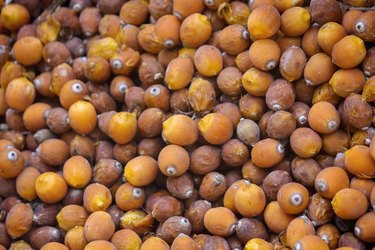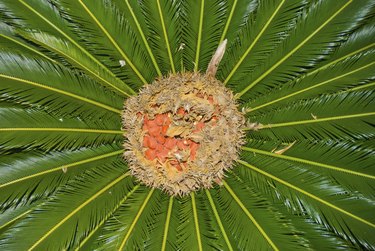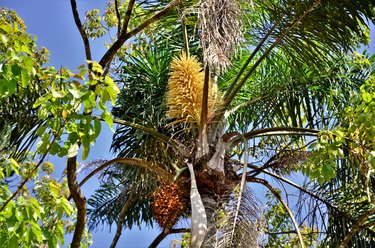
The queen palm tree (Syagrus romanzoffiana) earns its regal name with a mature height of 50 feet and sprawling, lacy fronds that easily reach 10 feet long. Growing in USDA plant hardiness zones 9-11, the queen palm suffers severe damage at 25°F and might die if temperatures reach 20°F. While it can grow well in climates at the colder end of its range, it must be protected from freezing temperatures.
Queen Palm Basics
Video of the Day

The queen palm is native to a forested region of South America that spans parts of Paraguay, Brazil and northern Argentina. Its excellence as a landscape tree quickly made it popular in other suitably balmy places, like Florida, California and Arizona. It prefers a sandy but fertile soil and full sun but will tolerate some shade and less than ideal soils. Alkaline soils are a problem and should be avoided because they can cause nutritional deficiencies.
Video of the Day
It's a fast-growing tree, shooting up 2 feet or more in a good year. As you'd expect given its growth rate, it's a heavy feeder and should be fertilized twice a year in spring and summer. Iron and manganese are important micronutrients that might need to be added separately in order to maintain health.
The tree's hugely impressive foliage—fronds 10-15 feet long containing individual leaflets reaching up to 2 feet in length—grows at the top of its tall gray trunk. The queen palm also produces clusters of bright orange fruit, sometimes called "dates," although they aren't true dates. They're edible, and you can make jams or desserts from the fruit pulp, but most homeowners don't bother. The tree is relatively low maintenance, so queen palm care comes down to just a few basics: water, irrigation, cleaning up fruits when they fall and periodically pruning away dead fronds to improve appearance.
Tip
Although Syagrus romanzoffiana is this tree’s current botanical name, it was previously known as Cocos plumosa and, more recently, Arecastrum romanzoffianum. You might find it at nurseries under either of those names or simply as a “cocos palm.”
How to Protect a Queen Palm From Cold

Though the queen palm is considered cold hardy as palm trees go, that's a relatively low bar. The tree can be badly damaged or killed by freezing temperatures. If you live at the colder edge of its growing range or in a cooler microclimate within its range, you'll need to take steps to protect the tree whenever cold temperatures are forecast. The goal is to protect the terminal bud, trunk and roots separately. It's also helpful to protect leaf fronds from transpiration.
Here's the breakdown:
1. Cover terminal bud
The terminal bud is the point from which all new growth originates and is the most important part of the queen palm tree to protect in a freeze. This bud is at the very top center of the tree where new fronds open. The best option for protection is to completely cover the tree from top to bottom with burlap, old blankets or frost cloth, trapping in warm air around the tree. The cloth should not touch the tree, so drive stakes in the ground that are slightly taller than the tree and drape the cloth over the stakes.
This method is only practical with young, small queen palms. For taller, more mature palm trees, you can drape the cloth over the fronds, tying it in place under the canopy.
2. Protect trunk
The palm's trunk needs to be kept warm if the tree is to survive. Frost cloth is an insulating material designed specifically to protect plants against frost, but practically any warm, insulating material works.
Try wrapping the trunk with several layers of blankets. Moving blankets work well if you don't want to strip your bed linens. Burlap, fleece and other fabrics can also be wrapped around the tree. If you don't have blankets or fabric to spare, you can use several layers of fallen palm fronds to insulate the trunk. Tie material on the trunk loosely and remove it when temperatures rise. Outdoor strand lights emit a small amount of heat from tiny bulbs and can help keep the trunk warm if you wrap several strands close together around the trunk.

3. Insulate roots
Queen palm roots get some insulation from soil, but a hard freeze can freeze the ground and roots. A layer of mulch roughly 6 in. deep helps insulate the ground to protect roots from frost damage.
If you've ever reached your hand to the center of a mulch or compost pile, you'll have noticed that decomposing materials are warmer than material on the outside of the pile. Shredded bark mulch is the most obvious choice, but any organic material can be used as mulch, including leaf mold, dried glass clippings or straw. Whichever mulch you use, keep the mulch a few inches away from the queen palm's trunk. Before the freeze occurs, water the queen palm's roots by thoroughly saturating the planting site. Water helps to insulate roots and keep them warm so they're better protected from freezing temperatures affecting the soil.
4. Use frost protection spray
Freezing temperatures draw moisture out of leaves—a process known as transpiration—and moisture freezes on leaf surfaces. Frost protection sprays, also known as anti-transpirants, are designed to coat leaves and prevent moisture from transpiring during freezing weather. These sprays can increase a queen palm's cold tolerance by as much as 9°F.
Spray a generous coat of frost protection spray on all queen palm fronds. Application instructions vary among products, but you can generally expect a single application to protect the queen palm for one month. While spray protects leaves and can be used on the terminal bud, it does nothing for the roots and trunk, so you'll still need to protect those.

With these simple and straightforward freeze protection tips, you'll maintain a pretty palm for years to come—even if you consider yourself a beginner gardener.